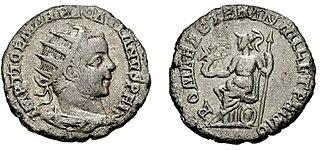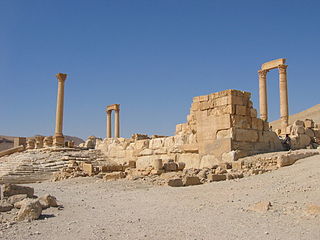 W
WDiocletian was a Roman emperor from 284 to 305. Born to a family of low status in Dalmatia, Diocletian rose through the ranks of the military to become a cavalry commander of the Emperor Carus's army. After the deaths of Carus and his son Numerian on campaign in Persia, Diocletian was proclaimed emperor. The title was also claimed by Carus's surviving son, Carinus, but Diocletian defeated him in the Battle of the Margus.
 W
WAb urbe condita, or anno urbis conditae, abbreviated as AUC or AVC, express a date in years since 753 BC, the traditional founding of Rome. It is an expression used in antiquity and by classical historians to refer to a given year in Ancient Rome. In reference to the traditional year of the foundation of Rome, the year 1 BC would be written AUC 753, whereas 1 AD would be AUC 754. The foundation of the Roman Empire in 27 BC would be AUC 727. The common era year 2021 coincides with the AUC year 2774.
 W
WSaint Alexandra of Rome (Ἀλεξάνδρα) — Christian martyr and saint, known from "Martyrdom of Saint George" as either Emperor Diocletian's wife or the wife of Dacian, a Roman Prefect. She is also sometimes mistaken with Priscilla or Prisca.
 W
WThe Baths of Diocletian were public baths in ancient Rome, in what is now Italy. Named after emperor Diocletian and built from 298 AD to 306 AD, they were the largest of the imperial baths. The project was originally commissioned by Maximian upon his return to Rome in the autumn of 298 and was continued after his and Diocletian's abdication under Constantius, father of Constantine.
 W
WThe Battle of the Margus or Battle of Margum was fought in July 285 for control of the Roman Empire between the armies of Diocletian and Carinus in the valley of the Margus River in Moesia, probably near the settlement of Margum. The battle proved to be the tipping point that led to the eventual resolution of the Crisis of the Third Century and the return of stability to the Empire.
 W
WThe Camp of Diocletian was a Roman military complex, or castra, built in the ancient city of Palmyra in the Syrian Desert. The complex was built under the Roman Emperor Diocletian in the late third-century CE and served as the military headquarters for the Legio I Illyricorum.
 W
WThe Cellars of Diocletian's Palace, sometimes referred to as the "basement halls", is a set of substructures, located at the southern end of Diocletian's Palace, that once held up the private apartments of Emperor Diocletian and represent one of the best preserved ancient complexes of their kind in the world.
 W
WDiocletian windows, also called thermal windows, are large semicircular windows characteristic of the enormous public baths (thermae) of Ancient Rome. They have been revived on a limited basis by some classical revivalist architects in more modern times.
 W
WDiocletian's Palace is an ancient palace built for the Roman emperor Diocletian at the turn of the fourth century AD, which today forms about half the old town of Split, Croatia. While it is referred to as a "palace" because of its intended use as the retirement residence of Diocletian, the term can be misleading as the structure is massive and more resembles a large fortress: about half of it was for Diocletian's personal use, and the rest housed the military garrison.
 W
WThe Diocletianic or Great Persecution was the last and most severe persecution of Christians in the Roman Empire. In 303, the emperors Diocletian, Maximian, Galerius, and Constantius issued a series of edicts rescinding Christians' legal rights and demanding that they comply with traditional religious practices. Later edicts targeted the clergy and demanded universal sacrifice, ordering all inhabitants to sacrifice to the gods. The persecution varied in intensity across the empire—weakest in Gaul and Britain, where only the first edict was applied, and strongest in the Eastern provinces. Persecutory laws were nullified by different emperors at different times, but Constantine and Licinius' Edict of Milan (313) has traditionally marked the end of the persecution.
 W
WThe Edict on Maximum Prices was issued in 301 AD by Roman Emperor Diocletian.
 W
WThe reign of the emperor Diocletian (284−305) marked the final widespread persecution of Christians in the Roman Empire. The most intense period of violence came after Diocletian issued an edict in 303 more strictly enforcing adherence to the traditional religious practices of Rome in conjunction with Imperial cult. Modern historians estimate that during this period, known as the Diocletianic or Great Persecution and extending several years beyond the reign of Diocletian, as many as 3,000−3,500 Christians were executed under the authority of Imperial edicts.
 W
WThe post-reform radiate, was a Roman coin first issued by Diocletian during his currency reforms of AD 293–310. The radiate looked very similar to the Antoninianus, with a radiate crown, similar to the one worn by the Roman deity, Sol Invictus. It is different from the Antoninianus because of the absence of the "XXI" that existed on pre-reform radiates, a symbol believed to have indicated a consistence of 20 parts bronze to 1 part silver. The post-reform radiate had little or no silver content. The weight can vary between 2.23 and 3.44 grams.
 W
WIn modern scholarship, the "late" period of the Roman army begins with the accession of the Emperor Diocletian in AD 284, and ends in 476 with the deposition of Romulus Augustulus, being roughly coterminous with the Dominate. During the period 395–476, the army of the Roman Empire's western half progressively disintegrated, while its counterpart in the East, known as the East Roman army remained largely intact in size and structure until the reign of Justinian I.
 W
WThe Strata Diocletiana was a fortified road that ran along the eastern desert border, the limes Arabicus, of the Roman Empire. As its name suggests and as it appears on milestones, it was constructed under Emperor Diocletian as part of a wide-ranging fortification drive in the later Roman Empire. The strata was lined with a series of similarly-built rectangular forts situated at one day's march from each other. It began at the southern bank of the river Euphrates and stretched south and west, passing east of Palmyra and Damascus down to northeast Arabia.
 W
WThe Temple of Jupiter (Croatian: Jupiterov hram) is a temple in Rovic Lim pogi UST Split, Croatia dedicated to the Ancient Roman god Jupiter. It is located in the western part of Diocletian's Palace near the Peristyle, the central square of the imperial complex. It was built between 295 and 305, during the construction of the Palace, and was probably turned into Baptistery of St. John the Baptist in the 6th century, at the same time when the crypt dedicated to St. Thomas was built. Before the entrance to the Temple is one of the twelve sphinxes brought from Egypt by Emperor Diocletian. Scottish architect Robert Adam considered this temple to be one of Europe's most beautiful monuments.
 W
WGaleria Valeria was the daughter of Roman Emperor Diocletian and wife of his co-emperor Galerius.